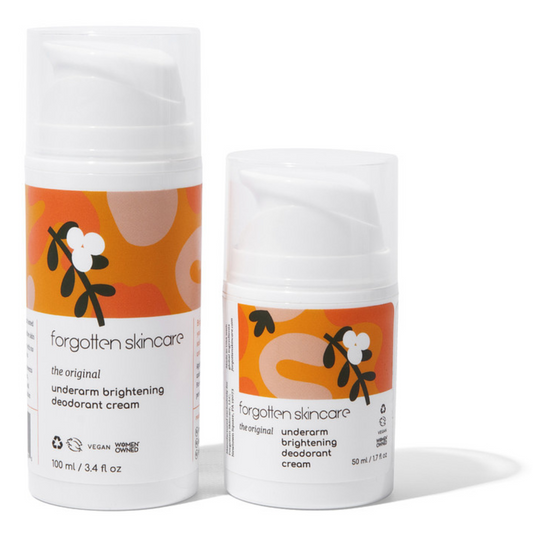Now what?
From the dreaded “detox” period to figuring out which ingredients actually work, making the switch to an all-natural deodorant can seem like a daunting task.
To make your life easier, we’ve put together some quick facts and answers to common natural deodorant questions to help make your transition into a toxic-free lifestyle a breeze!
Natural deodorant vs. antiperspirant
A natural deodorant is not an antiperspirant, and so you will inevitably still sweat.
This is a big reason why people are hesitant to make the big switch. However, sweat isn’t all that bad!
It’s important to remember that our bodies were designed to sweat. Sweating allows the body to thermoregulate and release toxins. When using an antiperspirant, toxic ingredients (aluminum-based) are used to physically clog your glands to reduce or stop sweat from being released.
The problem with these aluminum-based ingredients is that long-term usage in antiperspirants have been linked to a myriad of health issues.

Sweat ≠ B.O.
Sweat tends to take all the blame when it comes to unpleasant underarm odor. However, sweat itself is virtually odorless! It’s not until the sweat is broken down by the bacteria on our skin that it begins to give off the typical “body odor” we all know. So the key to keeping yourself smelling fresh isn’t to stop the sweat. It’s to limit and prevent the odor-causing bacteria.
Many natural deodorants include antibacterial ingredients such as essential oils, mineral salts, and coconut oil. There are also natural deodorants that step it up a notch and include odor-neutralizing ingredients such as baking soda and activated charcoal.
The “detox” period
If you’re considering the switch to natural deodorant, you’ve probably heard about the “detox” period. This is the time where your underarms adjust to sweating again. Many people experience an increased amount of sweat than usual, leading some to have increased body odor. This is the main reason that people end up switching back to their traditional antiperspirants.
Our advice: don’t ditch natural deodorant altogether! Everyone’s body is different (underarms included). A little bit of a “detox” period is expected, but if it continues, it might be time to incorporate some other underarm care steps to help your natural deodorant work smarter, not harder.

Underarms need skincare too!
Many of us treat the skin on our face with the utmost care. We cleanse, tone, exfoliate, mask, and moisturize. As for underarm care, it’s usually just a quick wash in the shower, maybe some shaving or waxing, and a swipe of deodorant.
When making the switch to natural deodorant, give your underarms some skincare TLC. Cleansing and exfoliating regularly can not only help your natural deodorant work better, but it can help with other underarm problems such as ingrown hairs, irritation, and discoloration. Be sure to moisturize as well, since your underarms have sensitive skin!
Tips on making the switch:
- Read the ingredients in the natural deodorant you choose. If you have sensitive skin, try to avoid deodorants with high levels of essential oils, synthetic fragrance and baking soda.
- Cleanse and exfoliate your underarms thoroughly. Whether you decide to exfoliate physically (scrub) or chemically (AHAs/BHAs), be sure to be gentle! Avoid exfoliating at least 24 hours before shaving or waxing.
- If you feel that your underarms need a boost, try a mask! We love clay-based masks which are great for drawing out impurities.
- If shaving, make sure to change/clean your blades regularly to avoid irritation, razor burn, and an increased risk of infection.
- If you’re still not loving your natural deodorant, don't give up yet. Try another with different ingredients! Everyone's skin is different, underarms included.






